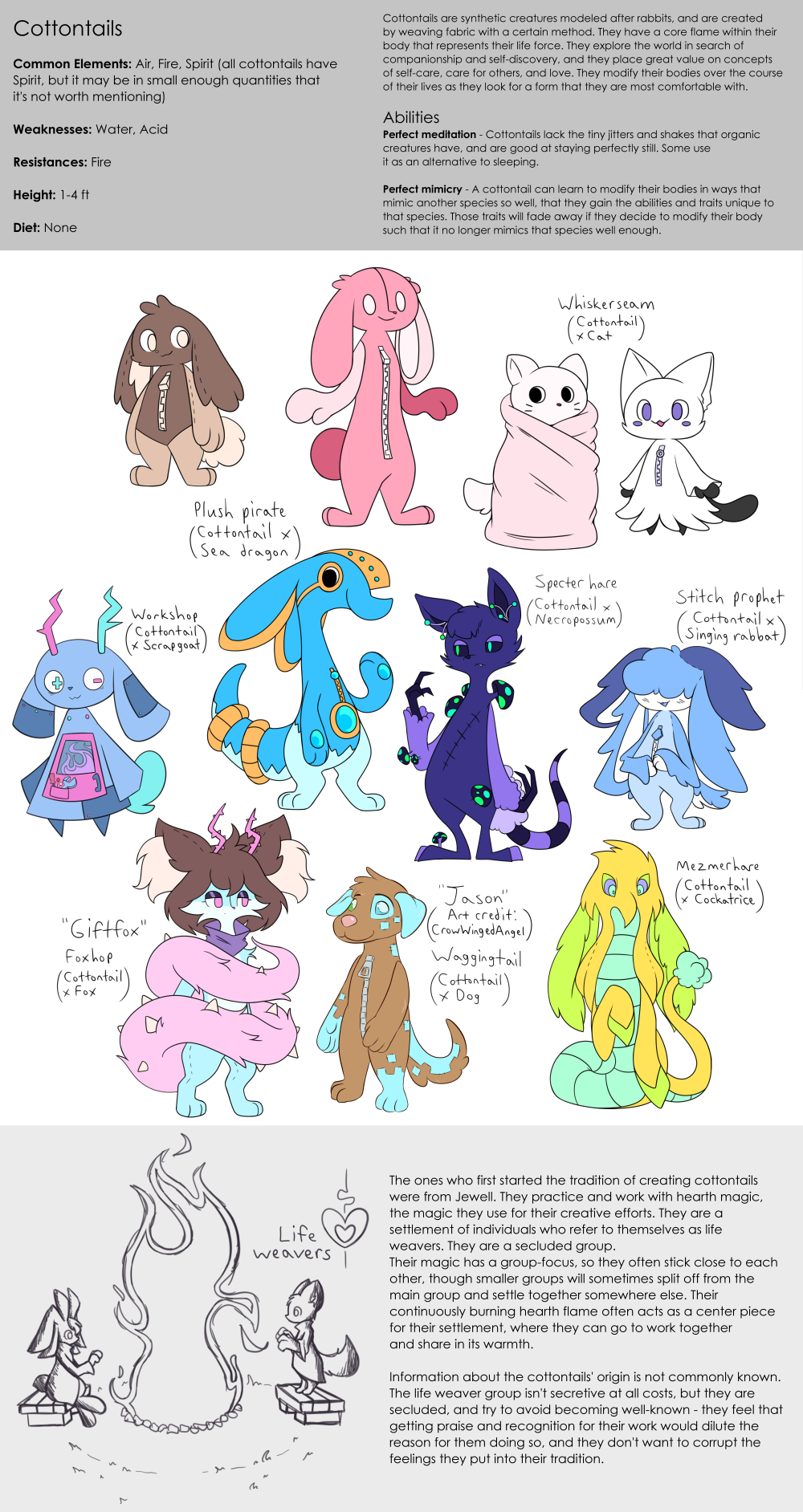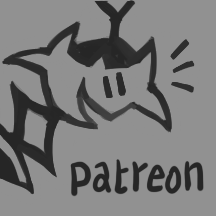Cottontails

Common Elements: Air, Fire, Spirit (all cottontails have Spirit, but it may be in small enough quantities that it's not worth mentioning)
Weaknesses: Water (weighs down the plush materials, and can be life threatening if exposed to the core fire), Acid (can damage the fabric in ways that are more difficult to fix than rips and tears)
Resistances: Fire
Height: 1-4 ft
Diet: None
Physiology
Cottontails are synthetic creatures modeled after rabbits, and are created by weaving fabric with a certain method. They are fairly light compared to biological creatures because of their fabric body. They have a core flame within their body that represents their life force. The flame will eventually wither out, even though the cottontail doesn't show any physical signs of aging during their lifetime. The fire is hot, but doesn't burn things. It can be affected by water and weather. Stoking it will not extend a cottontail's life, but dousing it is permanent and shortens their life unless quickly mitigated - the flame is strong enough that if there is only short-term exposure to damaging elements, it won't be impacted. The properties of the flame may differ depending on the individual's affinity - color is a common differentiation, but other traits can change as well. Individuals with similar affinities may not necessarily have matching flames, though. The flame can be used in some cases for magic, but it should only be done after study and training, so as to not negatively impact the cottontail's life force or safety. Most avoid trying this if they're not practiced, since it is a very obvious danger for a cottontail. When done by trained individuals, the practice is not self-damaging, though. Many cottontails use a zipper to facilitate maintenance and/or magical usage of their flame, but not everyone does this - such an easy access point can be a risk as well.
Cottontails can easily perform self-repair if their body is damaged, and they don't feel pain from such damage. They often carry around sewing pins, needles, et cetera, for repair at a moment's notice. However, they still try to avoid taking damage, because repair can only go so far, and they have their core to worry about. They often have trouble wrestling with their own mortality, and sometimes try to avoid the subject entirely. This is partly because of their capacity for self-preservation, and also because they have a direct physical representation of their life force that they can see at any point. On the other hand, this gives them an appreciation for life, and as a result they place great value on concepts of self-care, care for others, and love.
Behaviours
Since they do not have biological relationships, cottontails will often seek out found families and companions. Cottontails have been known to form bonds with each other that are similar to familial relationships, using terms such as "sibling" or "parent" to refer to each other, though they are often happy to form close relationships with other species too.
Many cottontails will collect soft things and make a pillow fort for them to sleep in, as a cozy little hideaway. If they have a companion they trust, they might sleep on a bed instead, and let their companion cuddle them like a plushie. The place they originate from, and the method of their creation, is generally unknown - they don't discuss either of these topics, even if asked. They tend to travel from wherever they originate from, to find a place that they can call home.
Some cottontails, as they begin to reach the end of their life, seek out a companion to entrust their body to - as they will become akin to a regular doll once they pass on, it's a somewhat common practice to find someone that they can trust to take care of their body after they've left this world. It's not necessarily a tradition, and it can be an uncomfortable thing to discuss and consider because of their relationship with mortality, but their penchant for self-preservation can often motivate them to figure this out.
Being modifiable dolls, cottontails can look pretty different from each other, and sometimes take completely different forms over their lifetime as they learn more about who they are and what their preferences are. They may also sometimes change themselves drastically to coincide with major changes in their lives, though this depends on the individual.
Hybrids
Cottontails are pure cottontail when first created, but as they get older, they may develop strong associations with other species. Some may modify their body to become pseudo-hybrids of the species that they identify with. They can become hybrids that are usually impossible, too, as they aren't restricted by reproductive compatibility. If they spend enough time in this form, they start to develop the traits and abilities of that species, effectively becoming true hybrids of that species. In order for this to happen, however, they do need to spend a fair bit of time around the species, so they can learn about them properly, and modify themselves in a way that properly reflects the species. The species' traits won't be taken on if the depiction is inaccurate...though there is room for creativity, as all beings are different in form. There are no documented cases of cottontails other than dreamers. It's unknown how an imp's ability to morph their body would interact with a cottontail's synthetic form and flame.
Typically, pure cottontails have a form that matches the simple and exaggerated features of a plushie, as they are made as one. This can vary, though. Cottontails that become hybrids may choose to change their bodies to have shapes more typical to biological creatures, in their attempts to mimic their fascinations - but many others choose to embrace their cottontail aesthetic more closely.
For hybrid cottontails, the synthetic, fabric body of a cottontail can lend itself to unique permutations of certain other species' abilities. For example, a species that has a unique type of skin (or similar analogue) can come through in the fabric of the cottontail. A plush pirate doesn't necessarily gain a wooden body, but their fabric will become coarse and somewhat rigid, to match a sea dragon's body somewhat. A workshop's fabric will change to mimic what they absorb - the depicted workshop's fabric has become very sturdy and shiny, mimicking a metal exterior. Abilities may be affected, too - when a specter hare uses Play Dead for example, they will no longer have a core flame, and as they have no flesh to rot, there will be a much more apparent funghi growth along the cottontail's fabric.
Origin
The ones who first started the tradition of creating cottontails were from Jewell. They practice and work with hearth magic, the magic they use for their creative efforts. They are a settlement of individuals who refer to themselves as life weavers. They are a secluded group, but they are willing to take in others if they need shelter, or if they have interest in the family's tradition - the family is even willing to teach their magic, if they feel the one wanting to learn is kind. They spend time every day tending to the flame that they use with hearth magic to give life to a cottontail. Their magic has a group-focus, so they often stick close to each other, though smaller groups will sometimes split off from the main group and settle together somewhere else. Their continuously burning hearth flame often acts as a center piece for their settlement, where they can go to work together and share in its warmth.
Life weavers create cottontails because they have a wish to spread more love and care throughout the world. They imbue their wish into their creations, and send those creations off to explore and give care in their own ways, and also look for places where they can experience care for themselves. Cottontails begin as rabbits, because for the life weavers, rabbits align with aspects of love, care, and companionship, and they want to give this energy to the cottontails they create.
Information about the cottontails' origin is not commonly known. The life weaver group isn't secretive at all costs, but they are secluded, and try to avoid becoming well-known - they feel that getting praise and recognition for their work would dilute the reason for them doing so, and they don't want to corrupt the feelings they put into their tradition. They have a symbol that they tend to carry around with them, which acts as a nice way of identifying each other without having to ask outright. While cottontails very often leave when they are created and don't talk about their creators to others, they are always welcome back if they ever wish to return.
Abilities
Perfect meditation - Cottontails lack the tiny jitters and shakes that organic creatures have, and are good at staying perfectly still. This is helpful if they need to hide in plain sight, or if they want to ignore the outside world for a little while. The ability is mostly based on patience - those who practice at it can learn to dissociate themselves to keep up the act for a good while. Some use it as an alternative to sleeping. This ability can cause confusion for those who aren't used to it - if you find a mysterious plushie lying around, try to check and make sure you're not disturbing a meditating cottontail!
Perfect mimicry - With study and time, a cottontail can learn to modify their bodies in ways that mimic another species so well, that they gain the abilities and traits unique to that species. Those traits will fade away if they decide to modify their body such that it no longer mimics that species well enough.
Species by Giftfox





![[Beleth looking bored]](https://floraverse.com/static/images/global-title-foreground-left.png)

![[Andre looking proud of his graffiti]](https://floraverse.com/static/images/global-title-foreground-right.png)






